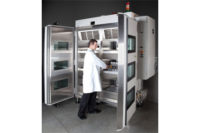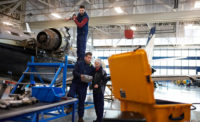

Last fall, after months of gathering information, the board investigating the Columbia shuttle disaster had pinpointed its cause and released a series of recommendations, including the increased use of nondestructive testing (NDT) and the development of new NDT technologies. Since then, there have been significant changes in NASA's space shuttle return-to-flight effort, the latest of which are detailed in the second interim report issued by the Stafford-Covey Task Group in May.
The task group was formed in the spring of 2003 to conduct an independent assessment of NASA's actions to implement the recommendations of the Columbia Accident Investigation Board (CAIB). The task group is co-chaired by retired U.S. Air Force Lt. Gen. Thomas Stafford, a former Apollo Mission commander, and Richard Covey, a former space shuttle commander and retired U.S. Air Force lieutenant general.
The CAIB had determined that a piece of insulating foam broke from the external fuel tank less than two minutes after Columbia took off and struck the left wing. The collision breached the thermal protection system on the leading edge of the left wing, and during re-entry, the breach allowed superheated air to enter the wing and melt electrical wiring and the wing's aluminum spars. This resulted in a weakening of the structure until aerodynamic forces caused loss of control, failure of the wing and breakup of the orbiter.
One of the changes in the Stafford-Covey task group report involves postponing the scheduled September 2004 launch to March or April 2005, because of several developments.
First, additional testing of the susceptibility of the thermal protection system, especially the reinforced carbon-carbon (RCC) panels, coupled with advanced analysis of the airflows around the orbiter, external tank and solid rocket boosters indicated that the foam on a larger area of the external tank should be stripped and reapplied. The external tank, which contains the propellant for the main engines, is the largest element of a space shuttle and is the common element to which the solid rocket boosters and the orbiter are connected.
Second, some rudder speed brake actuators were discovered to have been incorrectly assembled during the original assembly more than 20 years ago. Further, the gears in the actuators have generally suffered some damage with use and time, so all of the actuators are being replaced or refurbished.
And, third, a new camera/laser boom is to be built that will be used by the space shuttle's robotic arm to help inspect for possible damage while in orbit.
The return-to-flight task group is conditionally closing out three CAIB recommendations. "Closing out" a recommendation means that NASA has responded adequately to a specific recommendation. "Conditionally" means that the close out is dependent on the delivery of final information and the assurance of NASA that it will keep the task group up-to-date on any new developments pertaining to those recommendations.

NDT inspection
One of the CAIB recommendations being closed out regards RCC NDT inspection. CAIB recommended that NASA "develop and implement a comprehensive inspection plan to determine the structural integrity of all RCC system components. This inspection plan should take advantage of advanced nondestructive inspection technology."
Progress has been made in the development and implementation of an inspection plan for all RCC, according to the task group report. NASA has selected three NDT technologies for on-vehicle RCC inspection between missions: thermography, x-ray and eddy current. These technologies will be developed and fielded at Kennedy Space Center for use before the second flight of each vehicle and before all flights thereafter. The data produced will complement and enhance the protection against abnormal flight and processing damage offered by current visual and tactile inspections.
The manufacturer has rebaselined all RCC components for the Discovery and Atlantis Space Shuttles, and thermography has been completed at Kennedy Space Center. In the process of rebaselining, the original oxidation life reduction curves have been validated and the established schedules for refurbishing and replacing RCC panels and attach hardware have also been verified. No significant accumulated impact damage has been discovered in any RCC components, and no corrosion issues were found through examination of attachment hardware.
The manufacturer found a few minor voids that were introduced during manufacturing but went undocumented in the original acceptance screening. Some of these voids were analyzed in detail and found acceptable; others remain to be analyzed.
Afte components are NDT inspected at the vendor and shipped to Kennedy Space Center, thermography is used to establish a baseline and compare to original NDT inspection acceptance criteria. NASA's plan is to correlate the thermography data to the vendor NDT inspection data and other sensor data.
To help develop these technologies, NASA is establishing a server-based RCC NDT inspection database for easy retrieval of stored data as well as developing a Data Fusion visualization tool to accommodate the overlay of RCC NDT inspection data onto a Catia CAD model. This will enable visualization of NDT features using the structure CAD model, comparison of new NDT data with baseline data to evaluate changes in hardware condition, streamlining of data evaluation for Problem Report/Material Review disposition, and remote access to NDT data via the NDT database server.
Closeout inspection
Another CAIB recommendation being closed out regards closeout inspection. The board recommended that NASA "require that at least two employees attend all final closeouts and intertank-area hand-spraying procedures."
The CAIB later provided this clarification: "This recommendation was intended to apply to the entire Space Transportation System for all types of closeouts. The external tank intertank was specifically called out, but the recommendation was not limited to the tank."
According to the task group, "Excellent progress has been made." In particular, the external tank project has amended all manufacturing processes and procedures to ensure that at least two employees, and in most cases several more, are present at all manufacturing steps. This includes manual foam applications and all other flight closeouts, both at the Michoud Assembly Facility and Kennedy Space Center. Furthermore, NASA is satisfying more stringent quality assurance requirements through additional employee training, certification and work documentation of inspections and imagery, all of which have significant security benefits.
Thermal protection system
A CAIB recommendation that is not as far along is in regards to the thermal protection system (TPS) inspection and repair. The recommendation states that, "For missions to the international space station, develop a practicable capability to inspect and effect emergency repairs to the widest possible range of damage to the TPS, including both tile and RCC, taking advantage of the additional capabilities available when near to or docked at the International Space Station.
"For non-Station missions, develop a comprehensive autonomous (independent of Station) inspection and repair capability to cover the widest possible range of damage scenarios.
"Accomplish an on-orbit TPS inspection, using appropriate assets and capabilities, early in all missions.
"The ultimate objective should be a fully autonomous capability for all missions to address the possibility that an International Space Station mission fails to achieve the correct orbit, fails to dock successfully, or is damaged during or after undocking."
To meet the recommendation, NASA is developing the capability to resolve critical TPS damage in all areas. First, NASA is defining damage thresholds below which no repair is required, as well as thresholds above which repair is not deemed feasible.
Second, the agency is implementing a comprehensive in-flight inspection, imagery analysis and damage-assessment strategy.
NASA is also investigating the use of optical filters to highlight low-contrast damage. Tied in with this, it is investigating the use of impact sensors to limit the need for extensive in-flight inspection of the wing leading edge (WLE).
In the long-term, NASA is developing a sensor capable of 3-D damage measurement likely to be used with the orbiter boom. It's also developing a stand-alone, 3-D detection of tile and RCC damage, as well as an extravehicular activity repair capability independent of the International Space Station (ISS).
NASA is assessing several possible designs to inspect the WLE at a resolution necessary to detect critical damage. A review of the plans for the Orbital Boom Sensor System reveals several sensor risks. First, the OBSS schedule is aggressive and has no slack time reserve. Second, image stabilization and integration is a high-risk development task. Among the current challenges facing NASA are detecting low-contrast intensity differences, ranging relatively dark areas and temporal filtering (averaging).
As to NASA's implementation of its enhanced TPS inspection plan, the agency has developed technologies and operations for verification of tile and RCC repair procedures and tools as a detailed test objective on shuttle flight number STS-114. For STS-114, NASA has developed a flight plan that includes inspection of TPS on certain flight days to test its ability to obtain, downlink and evaluate information on all areas of the TPS. The flight plan currently contains a flight maneuver for the shuttle as it approaches the ISS to obtain images of the tiles using hand-held digital cameras aboard the station.
NASA intends to place sensors in the WLE to receive data on impacts to the edge during ascent. The Space Shuttle Program Office has created a flow chart for the process for all the participants to access and analyze the data coming from the Orbiter, and to make decisions on the health of the TPS and the potential need to repair the Orbiter prior to re-entry.
The road ahead
There has been substantial progress on virtually all of the remaining return-to-flight recommendations, the task group reports. It is anticipated that several more recommendations will be substantially met by the next task group plenary this summer.
One universal concern of the task group is the personnel requirements to meet the CAIB recommendations and return to flight. The various new organizations, from the NASA Engineering and Safety Center to the Space Shuttle System Engineering and Integration Office, all require talented staff drawn largely from the current NASA and contractor pool. At some point, the ability of the Space Shuttle Program to carry out its mission may be hampered by personnel shortages.
The most important work continues to be efforts to eliminate critical ascent debris. If it could be guaranteed that no critical debris would come from the external tank, the immediate cause of the loss of Columbia would be rectified. But such a guarantee is impossible, short of extensive testing in flight.
Analytical and testing techniques will allow a level of comfort before launch, and advances in NDT techniques may add to confidence. However, statistically significant results verifying external tank debris conditions may not be accomplished, even by the end of the Shuttle Program.
As such, on-orbit inspection and repair remain necessary to reduce the risk to future flights. Should one or both of these capabilities not be fully developed by the anticipated date of return to flight, the ability of the crew to await a rescue mission at the ISS will become an important consideration for the next launch.

